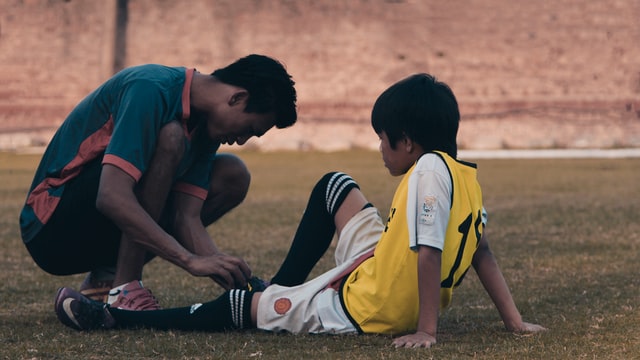What weekend warriors need to know about preventing and treating the seven most common sports injuries.
After a sedentary work week, end-zone catches and 36-hole weekends can take their toll on common sports injuries. The seven most common sports injuries are:
- Ankle sprain
- Groin pull
- Hamstring strain
- Shin splints
- Knee injury: ACL tear
- Knee injury: Patellofemoral syndrome — injury resulting from the repetitive movement of your kneecap against your thigh bone
- Tennis elbow (epicondylitis)
To see how to prevent and treat these common sports injuries — and to learn when it’s time to look further than your medicine cabinet to treat sports injuries— read on.
The Most Common Sports Injuries: Strains and Sprains
Sprains are injuries to ligaments, the tough bands connecting bones in a joint. Suddenly stretching ligaments past their limits deforms or tears them. Strains are injuries to muscle fibers or tendons, which anchor muscles to bones. Strains are called “pulled muscles” for a reason: Over-stretching or overusing a muscle causes tears in the muscle fibers or tendons.
“Think of ligaments and muscle-tendon units like springs”, says William Roberts, MD, sports medicine physician at the University of Minnesota and spokesman for the American College of Sports Medicine. “The tissue lengthens with stress and returns to its normal length — unless it is pulled too far out of its normal range”.
How to Prevent Sports Injuries
Sometimes preventing sports injuries is beyond our control, but most times, sports injuries are preventable. “Some injuries”, Roberts says, “we bring on ourselves because we’re not conditioned for the activity”. His advice: “Work out daily and get double benefit — enjoy your weekend activities and garner the health benefits”.
Every workout should start with a gentle warm-up to prevent injuries, says Margot Putukian, MD, director of athletic medicine at Princeton University. “Getting warmed up increases blood flow to the muscles, gets you more flexible, and could decrease injuries”, she adds.
Treating Common Sports Injuries
Often, these sports injuries are moderate or mild where you incur some damage, but all things are still in their right place. As such, you can treat these conditions at home through PRICE therapy method. We will look at this method later in detail. However, some of the injuries can take time to heal. In cases where you get a severe sprain or strain or the entire tendon, muscle, or ligament is torn, you may need surgery to treat the condition. Below are some of the tips you can use to treat mild and moderate sports injuries.
Ankle Sprain
It is one of the most common ankle injuries in sports. It occurs when a foot turns inward, stretching or tearing the ligaments outside of the ankle as they are pretty weak. When you get a sprain, exercise the foot to prevent loss of strength or flexibility. It also prevents re-injury. You can consult a physical therapist, doctor, or trainer for the best exercises.
However, if you experience a high-ankle sprain, it can take time to heal. You can visit a doctor to ensure the lower leg bones did not separate. You can recognize this type of sprain if you have tenderness above the ankle.
Hamstring Strain
A hamstring refers to the three muscles in the back of the thigh. When hurdling, kicking out the leg sharply as you run or water skiing can cause the hamstring to over-stretch. When this happens, the best treatment for a hamstring strain is resting whenever possible.
It can take 6 to 12 months to recover fully from this condition. However, whatever you do, avoid resuming the previous level of physical activity before the symptoms reduce or end completely. You can consult with a physical therapist to find the best time for this.
Shin Splits
Pain down the lower leg front is known as shin splints. Often, you get these injuries from running especially after you start a rigorous training program. The best sports injury treatment for this condition is rest, ice, or use over-the-counter pain medicine. Rarely is this condition caused by a stress fracture, a small break in the shin bone. So, if the pain persists after resting, you need to see a doctor. Stress fractures can take a month or so to heal.
Groin Pull
When you push off side to side when playing hockey, football, or baseball, you can experience strain in the inner thigh or groin. To treat this sports groin injury, use compression, ice and rest. Do not return to full activity immediately as this can aggravate the condition turning it into a long-term condition. If you see significant swelling in the groin, you need to see a doctor.
Knee Injury ACL Tear

ACL refers to the anterior cruciate ligament, which holds the leg bone to the knee. Sudden stopping or ‘cutting’ or being hit from the side can cause the ACL to strain or tear. You can hear a ‘pop’ sound when there is a complete tear. For this condition, it is always good to see a doctor when you suspect an injury. These are often severe sports injuries. If it is completely torn, the ACL will require surgery to allow for continued activity in sports.
Knee Injury: Patellofemoral syndrome
Patellofemoral syndrome can occur from repeating kneecap or patella movement against the thigh bone. This movement damages the tissue underneath the kneecap. Sports with most of these injuries include running, volleyball, and basketball. It can affect one or both kneecaps.
For this injury, you need to be patient. The pain can last for about 6 weeks for it to end. Continue with low-impact training as advised by the physical therapists during this time. You can also relieve pain by working out the quadriceps.
Tennis elbow (epicondylitis)
Using the elbow repetitively when playing tennis or golf can irritate or lead to tiny tears on the elbow’s tendons. People between 30 – 60 years often experience this condition. For this injury, the outer elbow is affected. You can rest from playing until the pain ends.
Using PRICE Principle to Treat Common Sports Injuries
Using the PRICE method to treat the most common sports injuries helps you back on your feet sooner. First, it is crucial to understand that swellings are normal after being injured. However, swelling excessively can affect the range of motion, interfering with healing. The PRICE method enhances quick healing by reducing swelling. This principle entails:
- P stands for protecting further injury: You can use a splint, pad, or crutch in the injured area to protect it from severe injuries.
- R is for restrict: Stop all forms of activity that can aggravate the injury.
- I is for ice: Apply ice immediately on the affected area. It is often referred to as the miracle drug in sports. Ice is anti-inflammatory and doesn’t have many side effects. For the next 48 hours after an injury, use ice for 20 minutes every one or two hours. Avoid heat as it encourages inflammation and swelling.
- C refers to compression: Use an elastic bandage to help manage the swelling.
- E stands for elevating the affected area. When you elevate the injured area above the heart, you reduce swelling.
Athletes also use over-the-counter medications to manage pain and swelling.
How To Prevent Sports Injuries
You can minimize the risk of getting injuries when you follow these tips:
- Always warm up thoroughly and stretch before a game.
- Wear the appropriate footwear and clothing
- Where necessary, strap vulnerable joints.
- Use safety gear such as mouth guards, pads, and helmets
- Drink a lot of fluids during and after the game.
- Avoid exercising when the day is too hot, that’s between 11 am and 3 PM
- Stay fit on and off-season
- Cross-train with other sports ensuring overall fitness and muscle strength
- Use good form and technique
- Cool down after the game and perform sustained stretches
- Give yourself enough time to recover between sessions
- Go for medical check-ups regularly




